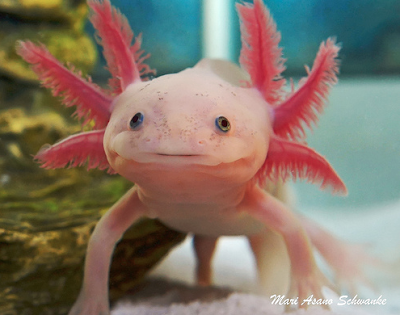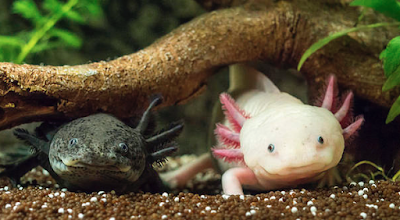SMILE FOR ME!
Recently I wrote a post about an unusual salamander that lives in North America. That salamander is called Hellbender. It is endangered due to pollution in our streams and rivers. This week we’re going to talk about another very unusual salamander, but this one lives in the lakes and surrounding water channels on the southern edge of Mexico City. Or that's where we believe he should be living.
Meet the Axolotl. Phonetically, it’s “Ax-oh-lot-ul.” Get a load of its adorable smile!
Okay, you can say it. That’s a really weird looking creature. And that smile—what can I say?
The pink creature you see in the above picture is not typical of the Axolotl. Typically, in the wild, this salamander looks like this…
They are usually brownish-green in the wild. They prefer that brackish, yucky, brown water with plenty of vegetation where they can hide. However, hiding is not working much for this creature anymore. It is critically endangered and is rarely found in its normal range, which as we stated above is near Mexico City. The pinkish color, which is not normal, was bred into this salamander.
Looking weird is not the only strange thing about the Axolotl, which is Aztec for ‘water dog.’ The Axolotl is named after a canine Aztec deity. Atl means ‘water’ and xolotl means ‘dog.’ Personally, I don’t think it looks much like a dog, and in trying to find out why it was so named, I came up empty. Sorry about that. However, in Aztec mythology, the dog-headed god, Xolotl, was a deity that would lead the souls of the dead to the underworld. Cool, huh?
Photo credit: Mari Asano Schwanke
The Axolotl not only looks unusual it is unusual. First, let’s talk about the wonderful plumage that this critter wears on its head. In the white variety, which is pictured above, their 'feathers' appear as dark pink frills and they are easily seen.
In the brown, or natural colored Axolotl, those frilly appendages are not as prominent. And they are not just there for show. Those frills are actually the salamander’s gills. They allow for gas exchange. This is how the Axolotl breathes.
Another interesting fact about the Axolotl is that it can regenerate body parts. There are a number of animals that can regrow parts they have lost. Lizards can regrow their tails, starfish can regrow their limbs, and the Axolotl can regrow its legs, but they don’t stop there. They can regrow their jaws, spines, and even their brains. Now that’s an amazing science fact.
Photo credit: Julia Moore
Not enough weirdness for ya? Let’s go one more. The Axolotl is unlike any other salamander in that it never fully matures. This is called neoteny. This means that the Axolotl remains in the larval stage and never becomes a true salamander. True salamanders lead normal amphibian lives marked by the ability to leave water and breath on land. After having said all that, this little guy is truly amazing. The Axolotl can metamorphose (change physical form or appearance) into an adult Mexican salamander if its habitat dries up. He’s weird and resourceful.
As a result of habitat loss, pollution, and the introduction of invasive species like tilapia and carp, these unusual creatures are being pushed closer to extinction. In 1998, about 6,000 were found in the wild. Today, researchers have been unable to find any.
My sincere thanks to Arkive.org for some of the pictures and information.
To learn more about this very unusual creature, visit the following sites:
Jeanne E. Rogers, Award Winning Author
The Sword of Demelza and The Gift of Sunderland
Middle-Grade Fantasy Where Endangered Animal Heroes Roam the Pages!








No comments:
Post a Comment